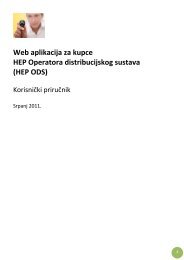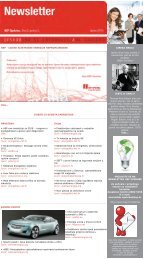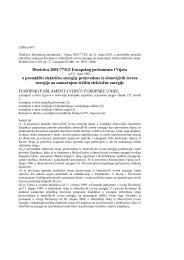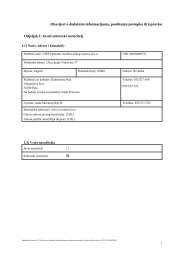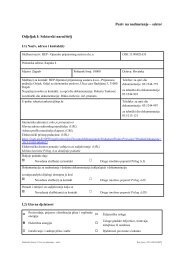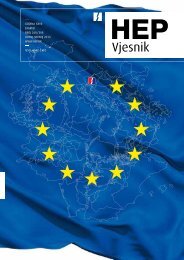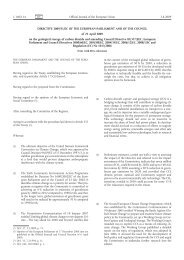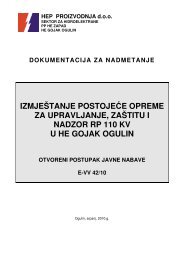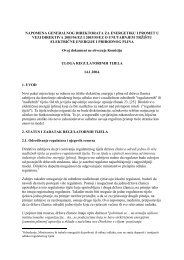DRAVA, KUPA, RJE»INA, LOKVARKA, LI»ANKA LIKA, DOBRA ...
DRAVA, KUPA, RJE»INA, LOKVARKA, LI»ANKA LIKA, DOBRA ...
DRAVA, KUPA, RJE»INA, LOKVARKA, LI»ANKA LIKA, DOBRA ...
You also want an ePaper? Increase the reach of your titles
YUMPU automatically turns print PDFs into web optimized ePapers that Google loves.
NOTES TO THE CONSOLIDATED FINANCIAL<br />
STATEMENTS OF THE HEP GROUP (CONTINUED)<br />
FOR THE YEAR ENDED 31 DECEMBER 2010<br />
2. SUMMARY OF SIGNIFICANT ACCOUNTING POLICIES (continued)<br />
TRADE DEBTORS AND PREPAYMENTS (continued)<br />
Outstanding receivables claimed through court and those included in bankruptcy estate (the debt principal and interest)<br />
are fully provided for, regardless of the number of past due days, and the provision is charged to expenses.<br />
INVENTORIES<br />
Inventories comprise mainly of materials and small items and are carried at the lower of cost, determined using the<br />
weighted average price less allowance for obsolete and excessive inventories, and net realisable value. The management<br />
provides for inventories based on a review of the overall ageing structure of inventories and non-recurring<br />
transfers over the years, as well as of individual significant amounts of inventories.<br />
Cost comprises the invoiced amount as well as all other costs directly attributable to brining inventories to<br />
their location and the condition of being readily available for use.<br />
CASH AND CASH EQUIVALENTS<br />
Cash and cash equivalents comprise cash on hand and demand deposits with banks and other short-term highly<br />
liquid investments that are readily convertible to a known amount of cash and are subject to an insignificant risk<br />
of changes in value.<br />
BORROWING COSTS<br />
Borrowing costs directly attributable to the acquisition, construction or production of qualifying assets, which are<br />
assets that necessarily take a substantial period of time to get ready for their intended use or sale, are added to the<br />
cost of those assets, until such time as the assets are substantially ready for their intended use or sale. Investment<br />
income earned on the temporary investment of specific borrowings pending their expenditure on qualifying assets<br />
is deducted from the borrowing costs eligible for capitalisation.<br />
All other borrowing costs are recognised in the statement of income in the period in which they are incurred.<br />
Short-term borrowings and supplier loans are recorded at original amount granted less repayment. Interest expense<br />
is charged to income statement on an accrual basis.<br />
FOREIGN CURRENCIES<br />
The individual financial statements of each Group entity are presented in the currency of the primary economic<br />
environment in which the entity operates (its functional currency). For the purpose of the consolidated financial<br />
statements, the results and financial position of each Group entity are expressed in Croatian kunas (HRK), which are<br />
the functional currency of the Company and the presentation currency for the consolidated financial statements.<br />
In preparing the financial statements of the individual Group entities, transactions in currencies other than<br />
the entity’s functional currency (foreign currencies) are translated to the functional currency of the entity at the<br />
rates of exchange prevailing on the dates of the transactions. At each reporting date, monetary items denominated<br />
in foreign currencies are retranslated to the functional currency of the entity at the year-end rates. Non-monetary<br />
items carried at fair value that are denominated in foreign currencies are retranslated at the rates prevailing on the<br />
date when the fair value was determined. Non-monetary items that are measured in terms of historical cost in a<br />
foreign currency are not retranslated.<br />
Exchange differences arising on the settlement of monetary items, and on the retranslation of monetary<br />
items, are included in profit or loss for the period. Exchange differences arising on the retranslation of non-monetary<br />
items carried at fair value are included in profit or loss for the period as finance cost except for differences arising<br />
on the retranslation of non-monetary assets available for sale, in respect of which gains and losses are recognised<br />
directly in equity. For such non-monetary items, any exchange component of that gain or loss is also recognised<br />
directly in equity.<br />
79<br />
HEP ANNUAL REPORT 2010<br />
CHAPTER 6 - FINANCIAL STATEMENTS



